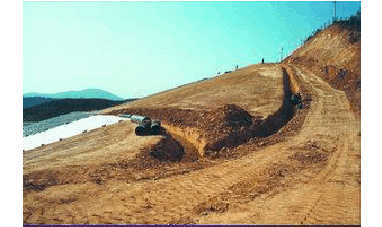There are two main ways to dispose of hazardous wastes: geological disposal and marine disposal. Marine disposal includes deep-sea abandonment and incineration. Land disposal includes land cultivation, permanent storage or reserve storage, land landfill, deep well filling and deep formation disposal, among which land landfill disposal technology is the most widely used. Marine disposal has been banned by international conventions, but geological disposal is still the most commonly used waste disposal method in the world.
I. Landfill Method
Landfill is one of the methods for the final disposal of hazardous wastes. This method includes site selection, landfill design, construction and landfill operation, environmental protection and monitoring, site utilization, etc. Its essence is to lay hazardous waste into a thin layer with a certain thickness, compact it and cover the soil. This treatment technology has been widely used at home and abroad. Landfill method is usually divided into sanitary land landfill and safe land landfill.
1. Sanitary Land Landfill
Sanitary land landfill is a method to dispose of general solid waste without endangering public health and environmental safety. It is mainly used to dispose of municipal garbage.
2. Safe Land Landfill
Safe land landfill is an improved sanitary landfill method, also known as safe chemical land landfill. Safe land landfill is mainly used to dispose of hazardous wastes. Therefore, the site construction technology requirements are more stringent. For example, the permeability coefficient of lining should be less than 10 < SUP > – 8 </SUP > cm/s, the leachate should be collected and treated, the surface runoff should be controlled, and the control and treatment of the generated gas should also be considered. In addition, there is a method of land landfill treatment, that is, shallow burial method. This method is mainly used to dispose of low-level radioactive waste.
Compared with other disposal methods, the main advantages of the land landfill method are as follows: it is a complete and final disposal method, and it is the most economical if there is suitable land for use; it is not limited by the type of waste and suitable for disposing of large amounts of waste; the land after landfill can be reused as parking lot and amusement park. Golf courses, etc. The disadvantage is that the landfill must be far away from the residential area; the recovered landfill will need constant maintenance due to settlement; the hazardous wastes buried underground may produce flammable, explosive or toxic gases through decomposition, which need to be controlled and treated.
II. Incineration Method
Incineration is a comprehensive process of high temperature decomposition and deep oxidation. By incineration, combustible hazardous waste can be oxidized and decomposed to reduce volume, remove toxicity, and recover energy and by-products.
The incineration process of hazardous waste is complex. Because the physical and chemical properties of hazardous wastes are complex, the composition, calorific value, shape and combustion state of the same batch of hazardous wastes will change greatly with time and combustion area. At the same time, the composition of exhaust gas and the properties of waste residue will also change after combustion. Therefore, hazardous waste incineration equipment must be adaptable, flexible and have the ability to automatically adjust operation parameters to a certain extent.
Generally speaking, almost all organic hazardous wastes can be treated by incineration, and incineration is the best way to treat them. For some special organic hazardous wastes, incineration is only suitable, such as some toxic intermediate by-products in petrochemical industry.
The advantage of incineration method is that it can reduce the volume of flammable hazardous waste rapidly and substantially. For example, in some newly designed incinerators, the volume of waste after incineration is only 5% or less of the original volume. Some hazardous wastes can destroy their composition and structure or kill pathogenic bacteria by incineration treatment, so as to achieve the purpose of detoxification and elimination. In addition, thermal energy can be provided by incineration. The disadvantages of the incineration method are as follows: firstly, the incineration of hazardous waste will produce a large number of acid gases, organic components and slag which are not completely burned, if discharged directly into the environment, it will inevitably lead to secondary pollution; secondly, the investment and operation management cost of this method is high. In order to reduce secondary pollution, it is necessary to control pollution in the incineration process. Facilities and sophisticated test instruments further increase processing costs.
CONTACT US
Address: No. 22 Binhe Road, Luoyang City, Henan Province, China
Tel: +86 379 64318689
Cell: +86 18237958898
E-mail:sales@lcdri.com
OUR PERSPECTIVE
Technology innovation
Energy & resource saving
Environment protection
Search
OFFICE HOURS
Mon-Fri: 8:30-17:30



